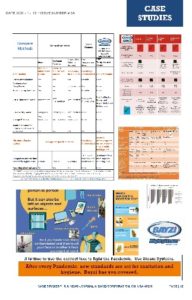Can we quantify cleanliness? What is ATP?
This is commonly measured by an ATP (Adenosine Triphosphate) test-meter that measures RLU’s (Relative Light Units) from swabbed regions. The number and types of bacteria present on a surface is of concern for infection control, but bacterial tests are sometimes very specific and do not yield the overall hygienic condition or cleanliness of a surface. RLU measurements on the other hand are more appropriate to define general cleanliness. ATP is a molecule found in and around living cells, and as such it gives a direct measure of biological concentration and health. ATP (adenosine triphosphate) is a molecule made up of an adenine ring, a ribose sugar, and most importantly 3 phosphates. In the most basic terms, this molecule is the body’s currency for all of its functions. Anything that the body does requires energy which all comes from ATP.The fats, carbs, and proteins that we eat are broken down and metabolized in order to replenish the used ATP in our bodies. One of the phosphates breaks off and releases a burst of energy. When this happens the molecule turns into ADP (adenosine diphosphate) because there is only 2 phosphates attached. Through a series of reactions another phosphate is attached and the molecule becomes ATP again. The ATP in our bodies are recycled after they produce energy.
ATP is quantified by measuring the light produced through its reaction with the naturally occurring enzyme luciferase using a luminometer. The amount of light produced is directly proportional to the amount of ATP present in a sample.
RLU (Relative Light Units) is the unit for measuring the ATP (Adenosine Triphosphate). ATP has been found to be a sensitive indicator molecule for the presence of biological residues due to its universal presence in all living cells (microbes, animal and plant cells). When a test swab is activated, a bio-luminescent reaction occurs, generating light output. RLU measurements will vary for the type of meter. However, because the ATP bio-luminescence reaction is linear, the more ATP present, the higher the contamination- indicates poor hygiene and vice versa. The presence of ATP on the surface indicates that it has not been adequately cleaned. An increase in “dirt” (mostly biological residues) on a surface is displayed in an increase in the amount of ATP present on that surface. Thus ATP an effective marker for the assessment of the hygienic status of an environmental surface. RLU’s measure this ATP.
ATP tests (the RLU measurements) are not intended to replace microbial tests but there is often a direct correlation between the results of the two types of measurements when done concurrently.
It is a common mistake for users to expect a close agreement between RLU measurements when comparing different systems (different makes of RLU measurement meters). This is due to the differences in RLU sensitivity, scales and outputs and the inherent variation of this biological assay and variations from sample distribution and sample collection. Therefore the ATP hygiene test (RLU counts) should not be considered as a precision assay for bacterial counts. The ATP hygiene test application is a sensitive, direct, objective test of cleaning efficiency and risk. It is a quick risk analyzer that help you suspect if there is a need to do further laboratory tests for a more detailed test for bacteria and particular species of bacteria. Care should be taken when comparing the system performance from different instruments or suppliers. Comparisons ahould be made with the same test machines and conditions.
The RLU measurements are great to infer if the cleanliness quality of a test surface or object has changed or if a particular cleaning system has efficacy in improving cleanliness. It is not a quantitative test for bacterial counts as it indicates different information than a CFU count test does.
When using RLU it is common to define a threshold of cleanliness. This is subjective in the sense that it depends on the machine employed. In fact some studies show that there is poor correlation between active bacteria and ATP measurements. ( Colbert et. al. Healthcare Infection, 2015,20, 108–114 Researchhttp://dx.doi.org/10.1071/HI15011), However this test is used often.
Here is a chart from A suggested sampling algorithm for use with ATP testing for cleanliness measurement (by G.S. Whiteley, T.O. Glasbey, P.P. Fahey,
Volume 21, ISSUE 4,
P169-175, December 01, 2016 https://doi.org/10.1016/j.idh.2016.11.003).Suggested cleanliness thresholds and corresponding RLU for 3 ATP device brands.

Last Page Vol. 3A

